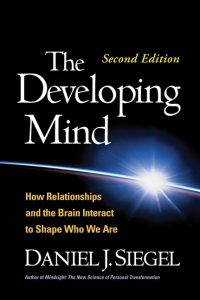A Framework for Cultivating Integration
From The Developing Mind: How Relationships and the Brain Interact to Shape Who We Are, Second Edition. By Daniel J. Siegel. Copyright 2012 by Mind Your Brain, Inc. Published by The Guilford Press. All rights reserved.
 As we come to the end of our journey into the developing mind, I want to make some brief suggestions about ways of applying the approach to integration described in this book. When a person, dyad, family, group, organization, or community experiences chaos and/or rigidity, then we know that integration is impaired.1 The key to moving the system toward well-being is to identify which elements are not differentiated and/or linked. This searchand-integrate process is helped by categorizing a set of “domains of integration” that can be the focus of the effort to bring health to a system. The following nine domains are important areas for energy and information to flow in an integrated way to create well-being, as described in various ways within this book’s nine chapters. These domains are also areas in which integration can be blocked. They provide a reasonable way to describe the terrain of differentiation and linkage. The nine domains are integration of consciousness, bilateral integration, vertical integration, memory integration, narrative integration, state integration, interpersonal integration, temporal integration, and transpirational integration. Together, they represent one way to begin to apply IPNB and its integration framework to your daily life in a practical and, I hope, useful way.
As we come to the end of our journey into the developing mind, I want to make some brief suggestions about ways of applying the approach to integration described in this book. When a person, dyad, family, group, organization, or community experiences chaos and/or rigidity, then we know that integration is impaired.1 The key to moving the system toward well-being is to identify which elements are not differentiated and/or linked. This searchand-integrate process is helped by categorizing a set of “domains of integration” that can be the focus of the effort to bring health to a system. The following nine domains are important areas for energy and information to flow in an integrated way to create well-being, as described in various ways within this book’s nine chapters. These domains are also areas in which integration can be blocked. They provide a reasonable way to describe the terrain of differentiation and linkage. The nine domains are integration of consciousness, bilateral integration, vertical integration, memory integration, narrative integration, state integration, interpersonal integration, temporal integration, and transpirational integration. Together, they represent one way to begin to apply IPNB and its integration framework to your daily life in a practical and, I hope, useful way.
In each of these domains, we can ask the following general questions. What aspects of this domain can be segregated functionally, temporally, or spatially so that differentiation is possible? How can this domain’s subcomponents be differentiated, or their differences cultivated and refined? Once they are differentiated, how do they become linked? Is the linkage severely restricted, limiting integration? Is the linkage accompanied by long-lasting dissolution of the differentiation, so that subcomponents lose their authentic, unique specializations? Linkage naturally entails “phase synchronization” so that resonance is achieved in the moment, but remember once again that achieving integration is more like making a fruit salad than making a smoothie: Individual components do not become lost in the blender. Heterogeneous functioning imbues integration with a sense of harmony, rather than the sameness of a homogeneous mixture.
THE NINE DOMAINS OF INTEGRATION
Integration of Consciousness
What can be differentiated within consciousness? As we have explored in Chapter 1, the subjective experience of awareness (the quality of knowing) and the object of awareness (that which is known) are separable elements of our conscious experience. Furthermore, the various objects of awareness can be differentiated from one anothe —the five senses from sight to touch; the sixth sense of the interior of the body; the “seventh sense” of mental activities; and our “eighth sense” of our interconnections with others and the world. When these aspects of consciousness are not differentiated, the experience of being aware can have a blurry quality, like an out-of-focus photo. The resulting image lacks depth, clarity, and stability. What we see is blurred in the focus of our attention. We may also view the object of attention as the totality of our identity when we do not distinguish awareness from that object of which we are aware. An intense emotion becomes who we are, not what we are feeling temporarily at that moment in time.
A practical approach to cultivating the integration of consciousness is the “Wheel of Awareness” practice—a form of focusing attention in an integrative, mindful way, as discussed in Chapter 7. In this metaphor for the mind, the hub represents awareness, and the points on the rim of the wheel represent that which we can be aware of—from sights and sounds to our sense of the body, our thoughts and feelings, and even our sense of connections to others. These are the elements of consciousness that can be differentiated from one another, and then linked. A metaphoric spoke can be sent systematically from the hub to any point on the rim. This integrative practice has been found to be quite useful with a wide range of people, including elementary school children. It is designed to be an integration-of-consciousness practice, but it also meets all the criteria for being a mindfulness practice: It cultivates curiosity, observation, acceptance, and a loving stance toward the self and others.
Bilateral Integration
As we’ve seen, the left and right hemispheres are quite distinct from one another. The two hemispheres have “intrinsic factors” from life in utero that differentiate the two sides. As we have explored in Chapter 6, impediments to differentiation can be present from innate causes (e.g., autism and nonverbal learning disabilities) or from experiential causes (e.g., suboptimal attachment). Impaired differentiation means that linkage is not possible, given that one needs to link elements that are distinct from one another. In autism, for example, there may be a premature closure of the early period of differentiation; as a result, the brain is actually larger, but its various areas are not uniquely specialized.2 In avoidant attachment, the hypothesis is that the left hemisphere is excessively differentiated and the right is underdifferentiated. Interventions would then be created to promote differentiation first, and then to cultivate linkages.
Linkage of the left and right hemispheres happens naturally in most people, so that we can say the brain generally works as an integrated whole. But for some, this does not occur. We can see impaired bilateral integration with incoherent narratives, with dysfunctional interpersonal interactions, and with blocked access to an internal awareness of emotions and bodily sensations. A systematic program can be created to promote the collaborative work of each of these ways of knowing and being in the world, left and right.3 The key in the overall approach to integration is to remember that the linkage of differentiated parts is a natural drive of a system to organize itself as it maximizes complexity. For bilateral integration, what this often means is discovering the fundamental process that is preventing each way of knowing from being equally valued; it may be a response to an event, the avoidance of a feeling, or a belief. With this new awareness, cooperation across the corpus callosum can then be achieved. Remember this: Openness to the body’s sensation and the accompanying wash of emotion is a nonrational, often ambiguous experience that can create a sense of vulnerability. These right-sided subjective sensations may feel quite fragile in the face of the more rational, logic-based, and language-defined left. Vulnerability is a sign of strength, however. Protecting the sometimes timid right in the face of the sometimes overly certain (and dogmatic) left is important in promoting bilateral integration. At other times and for other people, an excessively flooding right hemisphere needs the clear and rational soothing of the more somatically distant left hemisphere. Neither side is better than the other. The key to living a creative and fulfilling life is collaboration, not obliteration. Integration across the hemispheres entails respecting differences while cultivating collaborative connections between these two important but distinct ways of knowing.
Vertical Integration
If consciousness arises from the complex assemblies of neural firing in temporary phase synchronizations that involve a range of neural processes, 382 THE DEVELOPING MIND especially in the cortex, then vertical integration entails the awareness of subcortical input. Literally, this means focusing conscious attention on the
data from the body proper, the brainstem, and the limbic regions. Because these areas are anatomically “lower” than the cortex, we call this “vertical integration.” Differentiation along this axis is usually well established, given that in utero growth of the fetal nervous system occurs from bottom to top, and then from back to front. Recall that the nervous system has extensive innervation throughout the whole of the body—reaching to our muscles and bones, and distributed throughout our hollow organs, giving us the visceral input of the heart, lungs, and intestines. All of this “wisdom of the body” comes up the vagal nerve and up Lamina I in the spinal cord; makes stopovers in the brainstem and limbic/hypothalamic regulatory areas; and emerges into the middle prefrontal cortical regions of the anterior cingulate and insula, primarily on the right side of the brain. I am using the word “brain” here to mean the brain in the skull, or “head brain.” It is reasonable to call the intestinal input the “gut brain” and the heart’s input the “heart brain.” The “brain” is an embodied brain. Vertical integration makes this reality a part of conscious experience.
A simple exercise can offer others a direct experience of vertical integration—or the lack of it. Say “no” firmly seven times, and then follow that with a gentler “yes” seven times. “No” often elicits the reactive brainstem states of fight–flight–freeze. “Yes” activates the state of openness and social engagement, involving limbic and prefrontal modulation of the state of reactivity to one of receptivity. These bodily felt sensations of being reactive versus being receptive are a part of interoception—literally, the perception of the interior, which is what enables us to cultivate vertical integration. Often when someone has difficulty with interoception, there are important causes; going gently into this terrain is helpful. The window of tolerance for being aware of bodily states can be quite narrow if early attachment experiences were not supportive or if someone is innately sensitive or has intense responses. We live in our bodies, but sometimes we treat the body more like a transportation vehicle for the head than like a sanctuary of peace and pleasure, clarity and intuition.
Memory Integration
In Chapter 2, we have explored the layers of memory as they move from initial encoding in implicit forms of perception, bodily sensation, emotion, and behavioral response into the assembled puzzle pieces of explicit factual and autobiographical memory storage. As a child grows, he develops the important, socially shaped capacity to have a sense of self across time. This is embedded in implicit circuitry, and then is integrated by the hippocampus into explicit memory. Sometimes this process is blocked, as in trauma. When differentiated implicit memory remains in pure form, it can be seen as the flooding of emotion and images, automatic and sometimes rigidly dysfunctional behavioral habits, and intrusive bodily sensations. Implicit memory
also involves mental models based on prior experiences that filter our perceptions. One important aspect of implicit memory is that it can be retrieved and influence our conscious experience without our knowing that something from the past is having an impact on our lives.
Memory integration is the linkage of differentiated implicit memory into the explicit forms of factual and autobiographical memory with which we can exercise intention and choice. This makes our lives more flexible. Memory integration can make the difference between PTSD, with its impairments, and posttraumatic growth. Understanding memory integration helps bring clarity and resolution to overwhelming past events.
Narrative Integration
We humans are a storytelling species—one that “knows we know” (Homo sapiens sapiens). For at least forty thousand years (since the days of our early cave paintings), we have been making sense of our world by bringing the inside out, sharing what we see through our eyes with others. Narrative development is rich with examples of how our interpersonal relationships shape not only what and how we remember, but also how we learn to put words together to tell our experiences to others in story form. A story is the linear telling of a sequence of events, and so naturally narrative integration involves the left hemisphere’s linguistic, logical, linear drive to explain the cause–effect relationships of things in life. But autobiographical storage and the ability to understand our mental lives are predominantly right-sided affairs, suggesting that to tell a coherent story of our lives, we need collaboration between these two differentiated, lateralized ways of seeing and being in the world.
Narrative integration is the way we harness the power of the left and the storage of the right to make sense of our lived experience. The emergence of coherent narratives thus arises from bilateral integration and from intrahemisphere integration. Sometimes a coherent narrative can seem to have “appeared out of nowhere”—for example, as a person comes to resolution of some troubling event. James Pennebaker and colleagues have shown that the mere act of writing in a journal (as compared to dancing or drawing as an expression of a difficult past experience), even if never shown to anyone else, can have profound positive effects on bodily and mental well-being. Narrative integration is about making sense of our lives, and the research is clear that it makes sense to make sense.
State Integration
We’ve seen throughout our journey, and especially in Chapter 5, that the emergent mind arises from the interaction of neural and relational processes. Within our families, or with particular friends, we can become more likely to act in certain ways. We should choose our life partners and our friends wisely, as they will profoundly influence not just what we do and talk about, but actually who we will be. We are relational creatures, and the “self” is created in part within relationships. But our state of being in the moment— the self-state that arises—is also shaped by the synaptic shadows that reflect the ways we have adapted to our past experiences; by how those experiences have affected us directly; and also by innately determined neural development processes, such as genes, epigenetic controls, and toxic exposures. In other words, neural connections are shaped by both experience and by constitution to create personality. “Personality” can be described as the proclivity to travel down certain developmental pathways that directly shape selfregulation and our emotional lives.
How can one state of being, or state of mind, be differentiated from another? If I am in need of solitude, do I give myself permission to have time alone? Or is my gregarious state dominant, and do I thus feel guilty about saying “no” to offers for social events? Recognizing and then respecting the differing and often conflictual needs of distinct self-states is a part of “inter-state” integration. This can entail cultivating coherent functioning within a given state. So I give myself permission to learn to sail, and I cultivate a guilt-free (or minimally guilty) state of pleasure with time on the water, wind in my face, and tiller in my hand. This is a part of “intra-state” integration. Living a rich and full life entails at least these two aspects of differentiating (inter-state and intra-state) and then linking the many selves that define who we are. We also have an “interpersonal state,” which involves the next domain of integration.
Interpersonal Integration
Moving from “me” to “we” involves the differentiation of a personal, individual self and then the linkage of this self to another. A balanced relationship is an integrated entity. Often people come for clinical help with relational difficulties; they find their connections with others filled with chaos or rigidity. Fighting, emotional outbursts, and impulsive and sometimes destructive behaviors can dominate a relationship. For others, or at other times, a stagnant quality of predictability and boredom fill the relational landscape. In either case, integration is impaired. When one searches for the impediments to differentiation and/or linkage, they are often found in both members of the relationship.
The synaptic side of relational conflict can be revealed with the narrative window that the AAI offers. If this is being explored with a couple, then often we see how the partners get lost in familiar places; in other words, they have self-fulfilling prophecies that arise to reinforce the very conditions that these persons had as children. Interpersonal integration involves the honoring and relishing of differences while cultivating compassionate connections with others. One of the challenges of making interpersonal integrative changes is that people can fear being engulfed by another’s needs, or having their own needs for closeness, once acknowledged, go unmet. The retreat into isolation can sometimes feel more controllable than being flooded with a sense of needing another person for comfort and connection.
As we’ve discussed, for some the feeling of shame is subterranean, beneath the radar of awareness, and yet it dominates the relational world. With shame, people can have a buried belief of the self as defective, unworthy of connection, “damaged goods.” When people learn both conceptually and viscerally that shame has its developmental roots in impaired attachment, the path is opened to heal that early relational wound. It may have been a person’s way of preserving her sanity to think that she as a child was the defective one, rather than seeing her parents as the ones in trouble. The young child would have been paralyzed by terror of death if she believed that her parents were not able to be protective. Such reflections are the gateway to letting shame be understood and released. With such internal changes, the opportunity for interpersonal integration is made available; people can feel whole as they remain differentiated and yet deeply and intimately linked to others.
Temporal Integration
As we journey through life connecting with others, we also live within the homes of our bodies, which travel across the course of a lifespan with us. Not only do we have bodily selves, but we have cortices that are able to make maps of all sorts of things, including maps of time. These dogs sitting by my side as I write do not have the cortical architecture (we think) to make a map of time. When the sun rises, they know I’ll feed them soon, and they are excited. Each meal is like the first time they’ve eaten. Yet we humans often compare what is happening now with what occurred before. We may know that today is unique, but we also know that we cannot be certain of anything that life may bring. We may long for certainty, but we know that we cannot predict or control the outcome of things. We also know, because of our time-mapping cortical columns, that nothing lasts forever. Everything is transient. We all must die. My dogs are probably blessed with not having to worry about all of this.
Temporal integration is the way we differentiate our longings for certainty, permanence, and immortality from—and link them with—the reality of life’s uncertainty, transience, and mortality. When people deny one or the other side of this temporal slate, rigidity or chaos can ensue. A dear friend recently had a cancer successfully removed, yet she became profoundly depressed. At fifty years of age, she told me, she had never thought she’d have to face becoming ill or dying. She actually is not that unusual, as many people deny death and live as if this will never befall them. Her depression, even in the face of her full recovery from the surgery, is an example of a rigidity that comes from impaired temporal integration. These existential issues are a theme of our common humanity and a fundamental part of the world’s major religions. Learning to embrace our longing for certainty and constancy in the face of life’s realities is the essence of embracing temporal integration at the heart of our human lives.
Transpirational Integration
In my work as a psychotherapist over the past twenty-five years, I have found that using this model of integration has been a powerful way to reconceptualize human development. As people I worked with in therapy dove deeply into the eight domains just discussed, they would come to a common shift in their lives. This signaled the need to conceptualize a ninth domain of integration.
Transpirational integration signifies “breathing across” the other domains of integration—a kind of “integration of integration.” This form of integration involves a person’s sense of coming to feel connected to a larger whole. The “larger” here refers to a sense of belonging to something bigger than merely a bodily defined sense of self (as in vertical integration), or even to friends and family, as in interpersonal integration. Transpirational integration has the feeling that joining with others to give back to the world is as natural as taking care of oneself. For example, people may find themselves with a deep drive to help with cleaning up the local environment, reducing hunger in the community, or working to reduce child slavery or trafficking of young women. Even when the outcome of their efforts may not be known for decades, people may still feel the drive to become part of something larger than themselves—something that will make this home we share, our planet Earth, a better place for years ahead.
INTEGRATION AND THE “SELF”
The word “self” can be misleading. For some, “self” is a personalized identity defined by the body. “I” feed “myself” dinner, meaning that this body is eating food. But when we experience the integration of consciousness, such as in doing the Wheel of Awareness practice, we come to distinguish the experience of knowing (the wheel’s hub) from that which is known (the wheel’s rim).5 Many come to sense the infinite possibility of awareness contained within the differentiated inner hub. This awareness often gives rise to a sense of knowing that the body, a point on the rim, is only one of many ways to define what “the self” actually is. Defining the self as a singular noun is limiting. A broader view is that a self is a part of a much larger interconnected whole: the self can be seen as a “plural verb.” When we reflect on the notion of mind as an emergent process of energy and information flow in our bodies and in our relationships, we come to sense that our personal experience is a “node” in which energy and information flows through us, connects us to other nodes of flow, and makes us a part of a larger “mindweb” of interconnected individuals now, and across time. Within that interconnected whole rests the many ways we can experience our “selves” in the world.
Science reveals our deeply social and neurally embodied minds. When we embrace this perspective, we can see how health emerges from the integration of our interpersonal and bodily selves. Studies of happiness, health, and wisdom each reveal that positive attributes are associated with helping others and giving back to the world. We achieve a deep sense of meaning and accomplishment when we are devoted to something beyond our personal, individual concerns. Integration creates health and expands our sense of who we are in life, connecting us to others and a wider sense of ourselves. Being compassionate to others, and to ourselves, is a natural outcome of the healthy development of the mind. Kindness and compassion are integration made visible. If we take on the challenge of integration across its many domains, we may just be able to make a meaningful difference in the lives of people here now, and for future generations to come.
 From The Developing Mind: How Relationships and the Brain Interact to Shape Who We Are, Second Edition. By Daniel J. Siegel. Copyright 2012 by Mind Your Brain, Inc. Published by The Guilford Press. All rights reserved.
From The Developing Mind: How Relationships and the Brain Interact to Shape Who We Are, Second Edition. By Daniel J. Siegel. Copyright 2012 by Mind Your Brain, Inc. Published by The Guilford Press. All rights reserved.









Leave a Reply